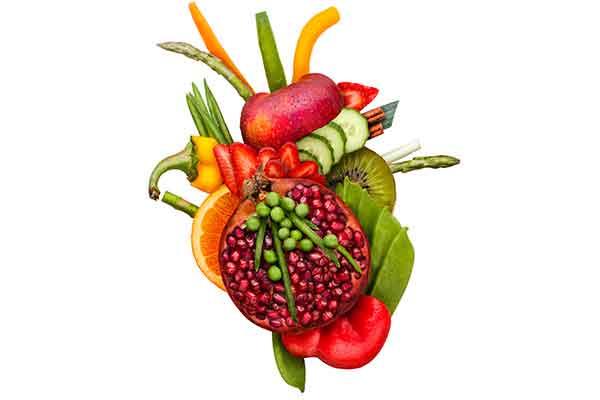Know your veggies, fruits and herbs

Know the benefits of veggies, fruits, nuts and herbs to help you select and make better choices.
Your diet plays a vital role in your well-being. It can help maximize physical and mental performance and also regain vitality. If you eat better, you will feel better and look better.
EATING FOR BETTER IMMUNITY
Ensure that you build better immunity levels by eating wholesome foods.
Of course, a perfect diet won’t always stop you from catching a cold or coming down with a flu, but you will suffer less, and bounce back more quickly from illness.
THE RAINBOW SPECTRUM
Different fruits and veggies are rich in different Vitamins, minerals and fiber.
So, aim for a variety, and pick your vegetables and fruits across the rainbow spectrum.
Eat at least five servings per day of fruits and vegetables, consisting of two servings of fruit and three servings of vegetables.
THE JUICY FACT
Fresh fruit or vegetable juice is a fantastic way to get your nutrients in a glass. But, remember juice has more calories and less fiber than eating the whole fruit or vegetable. Keep this in mind, especially if you want to cut back on calories.
COMBAT DISEASE
The plant kingdom is filled with nutrients that help prevent and fight disease. Awareness of their nutritional content can help combat illness.
Problem Consume
Obesity Lemon, watermelon, grapefruit, tomato, cucumber
High blood pressure Garlic, beet, onion
Diabetes Grapefruit, lettuce, tomato
Cholesterol Orange, onion, garlic, apple, soybean, coriander leaves
Arthritis Celery, banana, garlic, cucumber
Asthma Orange, Figs, grapes, drumstick, garlic, spinach, coconut
Constipation Papaya, banana, grapefruit, beet, carrot, mint
KNOW YOUR VEGGIES
Ranging from leafy vegetables, to edible roots, stems, fruits and seeds vegetables are protective foods used to build and repair the body.
GREEN LEAFY VEGETABLES
Green leafy vegetables such as spinach, lettuce and other greens are rich in iron, beta-carotene, chlorophyll, and dietary fiber. The darker the colored greens, the more nutritious and the higher the content of beta-carotene.
SPINACH
Key nutrients: Iron, chlorophyll, sulphur, Vitamin A
Benefits
Spinach builds blood, improves complexion and rids the body of toxins. It is a diuretic, and helps relieve constipation.
LETTUCE
Key nutrients: Chlorophyll, iron, Vitamin A and C.
Benefits
Lettuce improves the quality of blood, helps detoxify the body and is useful in the treatment of hemorrhoids.
FRUIT VEGETABLES
“Fruit” vegetables, such as tomatoes, squashes and peppers, contain ripened seeds of pollinated flowers. These are usually filling and yet low in calories.
TOMATO
Key nutrients: Calcium, phosphorus, iron, Vitamin C
Benefits
Tomato detoxifies the liver, purifies the blood and improves digestion. A rich source of Vitamin A, it helps treat eye problems. It is also helps control blood sugar levels (for diabetics) and reduces weight.
CUCUMBER
Key nutrients: Calcium, phosphorus, Vitamin C, iron
Benefits
Cucumber is a diuretic, it reduces toxins, purifies the blood and skin. It treats inflammatory conditions, including stomach inflammation, conjunctivitis, acne and inflamed skin.
FLOWERS, BUDS AND STALKS:
Flowers, buds and stalks include celery, cauliflower, broccoli and asparagus. These plants are rich in dietary fiber and Vitamin C.
CELERY
Key nutrients: Vitamins A, B and C, sulphur, silicon, iron
BENEFITS
Very high in silicon, celery helps strengthen joints, bones, arteries and all connective tissues. It helps treat rheumatism, arthritis, gout, and nerve inflammations.
ASPARAGUS
Key nutrients: Calcium, phosphorus, magnesium, iron, Vitamins A and C
Benefits
Asparagus contains the diuretic asparagine, which eliminates water through the kidneys. It also helps reduce cholesterol and high blood pressure.
ROOTS, BULB
Roots and bulbs are parts of a plant that store nutrients. Vegetables from this group are not generally low in calories, but are mineral –rich and filling.
ONION
Key nutrients: Sulphur, phosphorus, calcium, iron, Vitamin C
Benefits
Onion lowers blood pressure and cholesterol; treats dysentery; and is a common cure for respiratory disease. Iron is easily assimilated, and helps treat anemia.
DID YOU KNOW?
Juice of the raw onion can be used externally to reduce pain and swelling caused by insect bites.
CARROT
Key nutrients: Vitamin A, sodium, sulphur, chlorine, iodine, calcium
Benefits
Carrots improve vision, skin quality, and strengthen the teeth and gums. They also improve digestion and help purify the blood.
BEET
Key nutrients: Iron, potassium, calcium, magnesium.
Benefits
Beetroot helps digestion, reduces constipation and improves functioning of the kidney and gall bladder. The high iron content improves blood quality and reduces hypertension.
SEEDS AND PODS
Examples are peas, green beans, okra and drumstick. These vegetables contain more protein than other vegetables.
DRUMSTICK
Key nutrients: Calcium, phosphorus, iron, Vitamin C
Benefits
Drumstick strengthens the bones, purifies the blood, and treats asthma and other respiratory diseases. Its antibacterial properties help prevent infection.
KNOW YOUR FRUITS
Fruit provides fiber for a healthy digestive system, and antioxidant nutrients to protect the cells and tissues.
APPLE
Key nutrients: Vitamin C, iron, potassium, sodium, phosphorus, calcium, sulphur.
Benefits
Apples and their juice are cleansing and detoxifying. They help treat intestinal infections, inflammation of the colon, gout, diarrhea and acidity. Pectin, contained in the apple, reduces cholesterol.
AN APPLE A DAY
One apple, with the skin, has about 3.6 grams of fiber, nearly 17 percent of the recommended dietary fiber intake. An apple a day is enough to contribute substantially to colon health.
BANANA
Key nutrients: Potassium, folate, sodium, chlorine, iron, glucose, amino acids.
Benefits
Bananas help detoxify the body; often used to treat constipation and ulcers, they are good for the nerves, muscles and enhance functioning of the immune system. Rich in potassium and sugar, they also provide the body with nourishment and energy.
DID YOU KNOW?
A large banana has about 100 calories. It is richer in solids and lower in water content than most fresh fruits. It provides instant energy and quick recovery from fatigue.
CHERRY
Key nutrients: Iron, copper, magnesium, sucrose, Vitamin E
Benefits
Cherries are a remedy for arthritis, and rheumatism. Rich in iron, they improve the blood and treat anemia. Black cherry juice is excellent for gout, gums and teeth.
FIG
Key nutrients: Iron, magnesium, calcium, sulphur, Vitamin B, folate, fructose
Benefits
Figs improve digestion and functioning of the stomach, spleen-pancreas and large intestine. Rich in iron and calcium, they also improve blood quality and build strong bones.
DID YOU KNOW?
Figs help to balance acidic conditions that result from a diet rich in meat and refined food.
GRAPE
Key nutrients: Iron, potassium, phosphorus, glucose, salicylates, Vitamins B and E.
Benefits
High in sugar, grapes are a good source of energy. They contain valuable cell salts known to build and purify the blood (useful for anemia). Grape juice is a valuable remedy for liver malfunctions such as hepatitis and jaundice.
INTERESTING FACT
Grapes contain salicylates, the same compound used to make aspirin.
GRAPEFRUIT
Key nutrients: Potassium, folate, iron, amino acids, zinc, Vitamin B and C.
Benefits
Grapefruit helps protect the arteries, reduces the risk of cancer, aids digestion, speeds the breakdown of fat and boosts the immune system.
ORANGE
Key nutrients: Vitamin C, folate, potassium, sodium, citric acid, iron, manganese, calcium
Benefits
Orange is a general tonic for weak digestion, improves the immunity system and helps combat fevers. It regenerates body fluids and helps build strong bones and teeth.
DID YOU KNOW?
D-limonene, found in oranges, is a natural cholesterol lowering substance.
PAPAYA
Key nutrients: Vitamin A and E, silicon, potassium, calcium, copper, folate, fructose.
Benefits
Papaya contains the enzyme papain, which improves digestion. It reduces the risk of cancer, heart disease and cataracts. It also helps rid the body of intestinal worms, eases inflammation and combats constipation.
LEMON
Key nutrients: Vitamins B and C, calcium, iron, magnesium, potassium, sodium, citric acid.
Benefits
Lemon has antiseptic properties, and is useful during dysentery, flu, colds and coughs. It destroys bad bacteria, benefits the liver, promotes weight loss and purifies the blood. Lemon juice, diluted in water, cools the system (especially during summer) and calms the nerves.
PINEAPPLE
Key nutrients: Vitamins B, C and E, phosphorus, potassium, iron, folate, sucrose.
Benefits
Pineapple is a diuretic, which detoxifies the body, purifies the blood, prevents blood clots and increases circulation. It contains the enzyme bromelin, which improves digestive functioning.
POMEGRANATE
Key nutrients: Calcium, phosphorus, iron, sodium, Vitamin C
Benefits
Pomegranate aids digestion and helps destroy worms in the intestinal tract. The seeds are rich in fiber and provide roughage.
WATERMELON
Key nutrients: Phosphorus, potassium, sodium, calcium, iron, sucrose, Vitamins B and E.
Benefits
Watermelon is a diuretic, and can help reduce weight. It is a good source of lycopene, an anticancer substance. It is also used to treat kidney and urinary tract problems.
KNOW YOUR NUTS
Although we tend to think of nuts as snack foods, they are terrific sources of protein, Vitamins, minerals and healthy oils (especially Vitamin E). The protein is important for growth and repair of tissues, and the fat provides the body essential fatty acids, vital to health.
MODERATION IS THE KEY
Nuts can be addictive. Once you start eating them, it is hard to stop. Think handful, not bowlfuls. Limit your intake; eating too much will result in weight gain.
ALMOND
Key nutrients: Calcium, fiber, potassium, magnesium, phosphorus, folic acid.
Benefits
Almonds help treat skin diseases, impotency, constipation and respiratory disorders. In comparison to all nuts, almonds have the highest calcium and fiber content. They are called the king of nuts, because of their high nutritional value.
DID YOU KNOW?
Almonds are used extensively in beauty products. The oil is used to massage babies to keep their skin soft and supple.
PEANUT
Key nutrients: Protein, fiber, calcium, iron, sodium, potassium, Vitamins A, B and C.
Benefits
Peanuts are a complete source of protein. They contain a nutrient called resveratol, which helps treat heart disease and improve immunity levels.
PINE NUT
Key nutrients: Calcium, iron, magnesium, selenium, Vitamins A, B and C
Benefits
Pine nuts lubricate the lungs and intestines; improve functioning of the colon and help combat constipation
WALNUT
Key nutrients: Calcium, iron, phosphorus, potassium, sodium, Vitamins A, B and C.
Benefits
Walnuts help nourish the brain, strengthen bones and improve functioning of the intestines.
PISTACHIO
Key nutrients: Phosphorus, potassium, sodium, copper, magnesium, Vitamins A, B, C and E.
Benefits
Pistachios help purify the blood, and improve functioning of the liver and kidneys.
CASHEW NUT
Key nutrients: Iron, potassium, magnesium, Vitamin A.
Benefits
Cashews help treat anemia, improve the quality of complexion and boost the immune system.
KNOW YOUR HERBS
Herbs are leaves of aromatic plants, rich in nutrients and minerals. They are also used for medicinal purposes and sold over-the-counter as remedies for colds, flu, coughs, throat infections, rheumatic ailments and pain.
ADDING FLAVOR TO FOOD
Herbs are the perfect way to add flavor to food. Often used as seasonings, they can reduce reliance on salt. Use them to give subtle or strong accents to soups, sauces, stews and casseroles.
Aroma is a good indicator of quality in both fresh and dried herbs. Crumbling a few leaves can test the scent of herbs. A weak or stale aroma indicates old, less potent herbs.
BASIL
Key nutrients: Vitamins A and C, calcium, iron, magnesium, phosphorus, potassium.
Benefits
Basil helps treat headaches, dizziness, vertigo, stomach cramps, nausea and constipation. Basil oil is used to treat insect bites and minor cuts.
DID YOU KNOW?
Basil has wonderful medicinal properties. An infusion of the leaves is a quick home remedy for bronchitis and colds.
BAY LEAF
Key nutrients: Calcium, iron, magnesium, Vitamins A, B, C and E.
Benefits
Bay leaves are used to treat migraines, stress and anxiety. They also improve digestion and help detoxify the system.
INTERESTING FACT
Bay leaf oil is antibacterial. To repel household pests naturally, spread some crushed leaves in the kitchen cupboards.
CORIANDER LEAVES
Key nutrients: Vitamins A, B and C, iron, calcium, zinc
Benefits
Coriander leaves are diuretic, and help detoxify the system. They also help improve quality of blood, lower cholesterol levels and improve the eyesight.
MINT
Key nutrients: Calcium, phosphorus, iron, Vitamins A, C and E.
Benefits
Mint is used as a treatment for indigestion, colic, heartburn and flatulence. It also can stimulate the appetite and cure nausea and headaches. Peppermint tea can help soothe a dry throat.
INTERESTING FACT
Mint oil is used in throat lozenges and ointments for headaches.
Mint is also used to flavor mouthwash and toothpaste.
DILL
Key nutrients: Calcium, iron, magnesium, phosphorus, potassium Vitamins A, C and E
Benefits
Dill is used to treat colic, flatulence and indigestion. It is an effective appetite stimulant and helps stimulate milk in nursing mothers.
PARSLEY
Key nutrients: Vitamin C, chlorophyll, calcium, sodium, and magnesium, iron.
Benefits
Parsley improves digestion, blood quality and lowers blood pressure. It is also a treatment for anemia.
OREGANO
Key nutrients: Calcium, iron, phosphorus, potassium, magnesium, manganese Vitamins A and C.
Benefits
Oregano has powerful antioxidant and anticancer properties. It aids digestion, helps to get rid of intestinal parasites, treats nausea and diarrhea.
AT A GLANCE
VITAMIN/ MINERAL MAIN FUNCTION
Vitamin A Maintenance of skin, bone, vision, teeth
Vitamin C Maintenance of bones, teeth and improves immunity
Iron Improves the quality of blood
Calcium Important for bones and teeth
Note: If you are ill or under medication, consult your doctor for your nutritional requirements.





